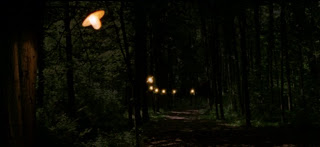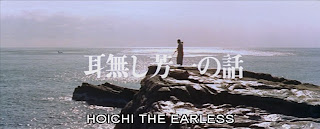
Okay. For those of you who aren’t horror fans, get that index finger going and scroll down to the next article. Because none of the following will be of interest to you. At all. But I would like those of you who are - those of you who can name the film that started it all and how old you were when you first watched it and what pattern was printed on your pyjamas – to ask yourself the following question: what is it I love about horror movies? For those with a real love of horror will undoubtedly begin your lists with words like, ‘atmosphere’ and ‘tension’. Yes; good effects help, as does a solid script and decent cast, but it’s the feeling that makes it really happen. Visuals are important of course, primarily the sets; foreboding castles perched on an outcropping in the Carpathians, twisted trees that appear to float above ground level because of an eddying ground-mist. Shock tactics if well deployed can be successful, but easily over-used. Every time the audience is made to jump – prompting laughter – the tension is broken, so this tactic can only be utilised a couple of times if the overall atmosphere is to be maintained throughout the film.
I’m not preaching and this isn’t a thesis – you all know this.
So; if we all know it, why doesn’t Hollywood? Why, at a time when even the most low-budget shoot has production values that the movie-brats of the seventies could have only dreamed of, does every director shoot horror movies as fucking action comedies!?!?
Sorry. Forgive me. But really. Stephen Sommers is the devil. ‘The Mummy’ as Indiana Jones? Karloff would have been getting his bandages all twisted spinning in his sarcophagus. And the concept of Michael Bay having his own production stable churning out remakes of many of the most famous chillers of the last twenty or thirty years would be hilarious if it weren’t so depressing. The naivety being demonstrated is unfathomable. What made ‘The Texas Chain Saw Massacre’ and ‘Halloween’ so memorable was the lack of gloss, the immediacy, the feeling that they were shot at the scene on the hand-held camera of a passer by. Watching these films, you can’t really imagine a film crew and lighting rigs and actors working from scripts (the fact that so many of the actors were poor doesn’t matter). Michael Bay does big, stupid, syrupy action films, and then for some bizarre reason obtains the rights to a handful of low-budget independent horror classics and produces them as big, stupid, syrupy action films.
Has the youth of today really got such a short attention span that they need a stabbing, a naked pair of breasts or an explosion every five minutes to keep them interested? Maybe so, maybe they have. Maybe it’s us – the old horror traditionalists – who are naïve. Maybe it’s all business and to hell with creating great films that can be enjoyed for generations.
I had my hopes briefly raised when I learned that the upcoming remake of ‘The Wolf Man’ was to be set in Victorian England (predating the contemporary set 1941 version) and would remain faithful to much of George Waggner’s original. Benicio Del Toro as Larry Talbot? I licked my lips. I’ve since learned the director is Joe Johnston. Joe-‘Jurassic Park 3’-‘Honey I Shrunk the Kids’-Johnston. ‘The Wolf Man’ as family-friendly actioner anyone? Er … no; no thanks. Even with Andrew Kevin Walker, who came over all gothic for ‘Se7en’ and ‘Sleepy Hollow’, having contributed the screenplay, things don’t bode well.


Let’s look at the facts: Best ‘Dracula’ adaptation? F. W. Murnau’s ‘Nosferatu’ (1922) or Todd Browning’s ‘Dracula’ (1931). Best ‘Frankenstein’? James Whale’s 1931 version. Karl Freund gave us the definitive ‘Mummy’ in 1932 and the aforementioned 1941 ‘Wolf Man’ remains arguably the best werewolf movie (with a respectful nod to John Landis’s ‘An American Werewolf in London’). See the pattern? Steady pacing, classic themes, iconic monsters and all simply dripping in atmosphere. Watch ‘The Creature from the Black Lagoon’ again. Scary? No, not today it’s not. But wonderfully effective, despite the man-in-costume-that’s-so-tight-he-can’t-bend-his-arms-or-legs-creature, with a lovely sense of claustrophobia and many memorable scenes (you’ll wonder how many times a young Steven Spielberg watched the film for inspiration whilst on the set of ‘Jaws’).
So again; is there no one out there with the courage to make an old-fashioned character driven, straight-faced horror movie? William Friedkin didn’t deem it necessary to throw in a few jokes or a scene or two of slapstick in ‘The Exorcist’, did he? Kubrick managed to successfully adapt ‘The Shining’ without changing the cast into a group of teenagers who’d broken into The Overlook Hotel to smoke dope and boing each other.
So, come on then; ten great, non-comic horror films aimed at adults since ‘The Shining’? Bet you can’t do it. I can’t. ‘The Evil Dead’? Undeniably great, but tongue-in cheek. ‘Near Dark’? More cool than scary. ‘28 Days / Weeks Later’? Convincing end of the world feel these two, you’re glad to put the lights on after they’ve finished and look outside to make sure everything’s still normal. What about the 1982 version of ‘The Thing’, which was a brilliant exercise in paranoia and suspense directed by John Carpenter who - like Landis - seemingly decided that directing half a dozen cracking movies was enough and that all of his future output would be consistently shite. We’ve relied on the Far East for serious chills over the past decade with ‘The Ring’, ‘The Grudge’, ‘The Eye’ etc, but even these titles are quickly becoming generic and tired. Europe? Tomas Alfredson’s ‘Let the Right One In’ can not only claim best horror film of last year, but must feature in the top three or four of any genre.
Right; what about those faithful literary horror adaptations of the nineties? Both Coppola’s ‘Bram Stoker’s Dracula’ and Branagh’s ‘Mary Shelley’s Frankenstein’ (Jesus, what’s with the name checking?) were worthy but dull romantic costume dramas, not horror films.
So please. Somebody. Please. Somebody please make a great horror film.
Joe Johnston?
Maybe. You never know.
But don’t bet on it.
by Paul Rowe

























































































